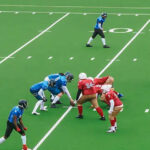Fire compartmentation is a critical aspect of modern building design, aimed at preventing the spread of fire and smoke. One of the most essential tools in implementing effective fire compartmentation is the fire compartmentation sleeve, a device used to maintain fire resistance in penetrations created for pipes, cables, and other building services. This guide explores the importance, functionality, installation, and maintenance of fire compartmentation sleeves, as well as their role in compliance with fire safety regulations.
Understanding Fire Compartmentation
What Is Fire Compartmentation?
Fire compartmentation is a fire safety strategy that involves dividing a building into separate sections, or compartments, to contain fire and smoke within a limited area. This delay in the spread of fire provides occupants more time to evacuate and allows firefighters to control the blaze more effectively.
Components of Fire Compartmentation
- Fire-Resistant Walls and Floors: These structural elements prevent the spread of fire between compartments.
- Fire Doors: Designed to resist fire and smoke while allowing safe egress.
- Fire Stopping Products: Including fire compartmentation sleeves, these seal openings created for building services.
The Role of Fire Compartmentation Sleeves
A fire compartmentation sleeve is a fire-resistant device installed around pipes, cables, or ducts that pass through fire-rated walls, floors, or ceilings. Without these sleeves, these penetrations could compromise the integrity of the fire-resistant barrier, allowing fire and smoke to spread.
Key Functions of Fire Compartmentation Sleeves
- Fire Containment: Maintains the fire resistance of walls and floors by sealing openings.
- Smoke Control: Prevents the spread of toxic smoke, which is often more dangerous than fire itself.
- Compliance with Regulations: Ensures that the building meets fire safety standards and codes.
Types of Fire Compartmentation Sleeves
Fire compartmentation sleeves come in various types to cater to different needs and applications. These include:
1. Intumescent Sleeves
- Made from materials that expand when exposed to heat, these sleeves effectively seal gaps and prevent fire spread.
- Commonly used for plastic pipes that may melt during a fire.
2. Metal Fire Sleeves
- Constructed from steel or other fire-resistant metals, these sleeves are ideal for high-temperature applications or large penetrations.
3. Flexible Fire Sleeves
- Designed for cables or ducts, flexible sleeves allow for easy installation while maintaining fire resistance.
4. Pre-Installed Sleeves
- Integrated into fire-rated walls or floors during construction to simplify installation and ensure compliance.
Standards and Regulations Governing Fire Compartmentation Sleeves
International Standards
Fire compartmentation sleeves must meet stringent fire safety standards, including:
- EN 1366-3: European standard for fire resistance testing of service penetrations.
- UL 1479: American standard for fire tests of penetration firestops.
- ISO 834: Global standard for fire resistance tests.
Building Codes
Compliance with local building codes is mandatory. These codes often specify the use of fire compartmentation sleeves in certain types of buildings or installations.
Certifications
Products should carry certifications from recognized testing bodies, such as FM Approvals or Underwriters Laboratories (UL), to ensure reliability.
Installation of Fire Compartmentation Sleeves
Proper installation is crucial to ensure the effectiveness of fire compartmentation sleeves. The process involves several steps:
1. Preparation
- Assess the penetration to determine the appropriate type and size of sleeve.
- Clean the opening to remove debris and ensure a snug fit.
2. Installation
- Insert the sleeve into the penetration according to the manufacturer’s guidelines.
- Secure the sleeve using the recommended method, such as anchors or adhesive.
3. Sealing
- Use fire-resistant sealant to fill any gaps around the sleeve, ensuring a complete barrier against fire and smoke.
4. Inspection
- Verify that the installation meets fire safety standards and the manufacturer’s specifications.
Tips for Successful Installation
- Always follow the manufacturer’s instructions.
- Use certified products to ensure reliability and compliance.
- Conduct periodic inspections to maintain effectiveness.
Maintenance of Fire Compartmentation Sleeves
Regular maintenance is essential to ensure that fire compartmentation sleeves remain effective over time.
Inspection Guidelines
- Visual Checks: Look for damage, wear, or gaps around the sleeve.
- Testing: Conduct fire resistance tests periodically, if feasible.
- Documentation: Keep records of inspections and maintenance activities.
Common Issues
- Physical Damage: Caused by accidental impacts or environmental factors.
- Improper Installation: May result in gaps or compromised fire resistance.
- Aging: Materials may degrade over time, especially in harsh environments.
Advantages of Fire Compartmentation Sleeves
- Enhanced Safety: Prevents fire and smoke spread, protecting occupants and property.
- Regulatory Compliance: Meets fire safety standards and reduces liability.
- Cost-Effective: Reduces the need for extensive repairs or upgrades in case of fire.
- Versatility: Suitable for various building services, including pipes, cables, and ducts.
Common Applications
Fire compartmentation sleeves are used in a variety of settings, including:
1. Commercial Buildings
- Office complexes and shopping malls benefit from enhanced fire safety measures.
2. Residential Buildings
- Apartments and high-rise buildings require compartmentation to protect residents.
3. Healthcare Facilities
- Hospitals and clinics need robust fire barriers to protect vulnerable patients.
4. Industrial Facilities
- Factories and warehouses require fire sleeves for large-scale installations.
Future Trends in Fire Compartmentation Sleeves
- Smart Fire Sleeves:
- Integration of sensors to monitor the condition of fire sleeves and alert maintenance teams of any issues.
- Sustainable Materials:
- Use of eco-friendly materials that maintain fire resistance while reducing environmental impact.
- Improved Installation Methods:
- Innovations in design to simplify installation and reduce labor costs.
Conclusion
Fire compartmentation sleeves are indispensable for maintaining the integrity of fire-resistant barriers in modern buildings. By choosing the right type of sleeve, ensuring proper installation, and adhering to maintenance protocols, building owners and managers can significantly enhance fire safety and comply with regulatory requirements. As fire safety technology evolves, fire compartmentation sleeves will continue to play a vital role in protecting lives and property.
FAQs
1. What is a fire compartmentation sleeve?
A fire compartmentation sleeve is a fire-resistant device installed around penetrations for pipes, cables, or ducts to prevent fire and smoke from spreading through walls, floors, or ceilings.
2. How does a fire compartmentation sleeve work?
Fire sleeves create a barrier that maintains the fire resistance of a wall or floor. Some sleeves expand when exposed to heat, sealing gaps and preventing fire spread.
3. Are fire compartmentation sleeves mandatory?
Yes, in most cases. Building codes and fire safety regulations often require the use of fire compartmentation sleeves in fire-rated barriers.
4. How do I choose the right fire sleeve for my building?
Consider the type of penetration (e.g., pipes or cables), the fire resistance rating required, and the manufacturer’s recommendations.
5. Can I install fire compartmentation sleeves myself?
While some sleeves are designed for easy installation, it’s recommended to hire a certified professional to ensure compliance with safety standards.
6. How often should fire compartmentation sleeves be inspected?
Regular inspections should be conducted annually or as specified by local regulations and the manufacturer’s guidelines.











